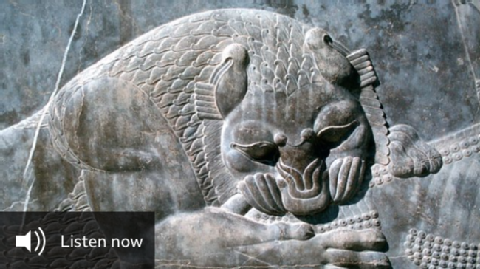Audio and Visual Resources for Persian Empire 559-465BC
Stupid Ancient History - Persian Empire

 Dave Midgley and Helen Taylor are Director of Humanities and Head of History respectively at Parrs Wood High School and have been teaching Ancient History at GCSE and A Level for longer than either of them would probably like to admit. James Hill is the Science technician Manager at Parrs Wood, long-suffering accomplice to their various shenanigans and resident non-expert in all things Ancient History.
Dave Midgley and Helen Taylor are Director of Humanities and Head of History respectively at Parrs Wood High School and have been teaching Ancient History at GCSE and A Level for longer than either of them would probably like to admit. James Hill is the Science technician Manager at Parrs Wood, long-suffering accomplice to their various shenanigans and resident non-expert in all things Ancient History.
Cyrus and the Lydians Questions
Darius Secures his Rule Questions
Behistun Inscription Questions
Darius' Building Projects Questions
Darius and the Scythians Questions
Causes of the Ionian Revolt Questions
Events of the Ionian Revolt Questions
Hoplites and Immortals Questions
The Battle of Marathon Questions
From Darius to Xerxes Questions
Battle of Thermopylae Questions
The Battle of Salamis Questions
The Battle of Plataea Questions
Videos
The Persian Empire, 559-465 BCE
Persepolis
[Source: BBC Radio Four In Our Time]
Melvyn Bragg and guests discuss the role of the great 'City of the Persians' founded by Darius I as the ceremonial capital of the Achaemenid Empire that stretched from the Indus Valley to Egypt and the coast of the Black Sea. It was known as the richest city under the sun and was a centre at which the Empire's subject peoples paid tribute to a succession of Achaemenid leaders, until the arrival of Alexander III of Macedon who destroyed it by fire supposedly in revenge for the burning of the Acropolis in Athens.
With Lloyd Llewellyn-Jones (Professor of Ancient History at Cardiff University), Vesta Sarkhosh Curtis (Curator of Middle Eastern Coins at the British Museum), and Lindsay Allen (Lecturer in Greek and Near Eastern History at King's College London)
Persepolis Regained
[Source: BBC World Service Masterpiece]

Persepolis existed for 14 centuries until Alexander the Great burnt it to the ground. Presenter Vesta Sarkhosh Curtis takes a trip to the ruins of the ancient capital of the Persian Empire located near Shiraz in the South of modern day Iran.
The Cyrus Cylinder
[Source: British Museum, Published on 18 Jul 2014]
The Cyrus Cylinder is one of the most famous objects to have survived from the ancient world. It was inscribed in Babylonian cuneiform on the orders of Persian King Cyrus the Great (559-530 BC) after he captured Babylon in 539 BC.
The cylinder is often referred to as the first bill of human rights as it appears to encourage freedom of worship throughout the Persian Empire and to allow deported people to return to their homelands. It was found in Babylon in modern Iraq in 1879 during a British Museum excavation.

